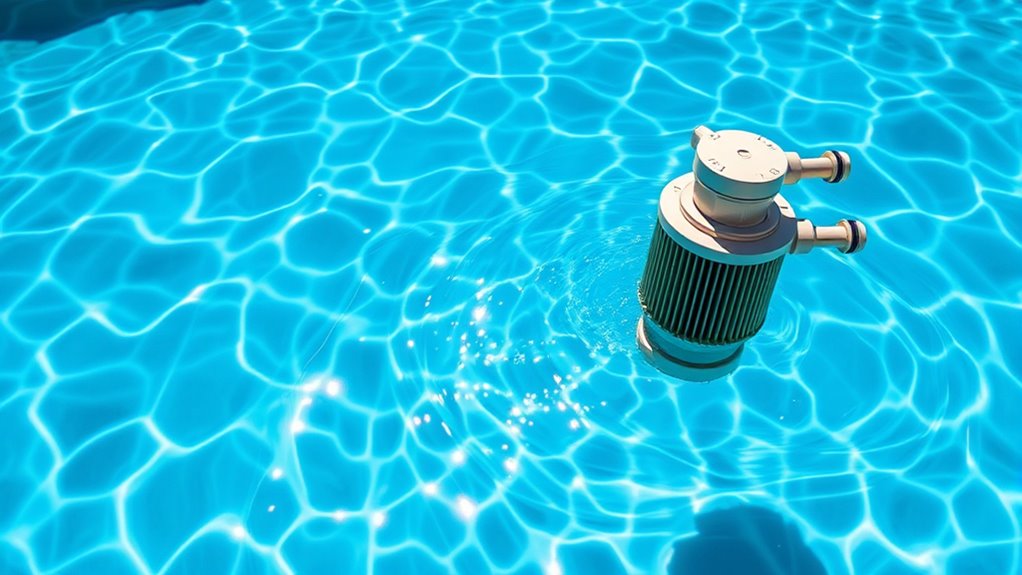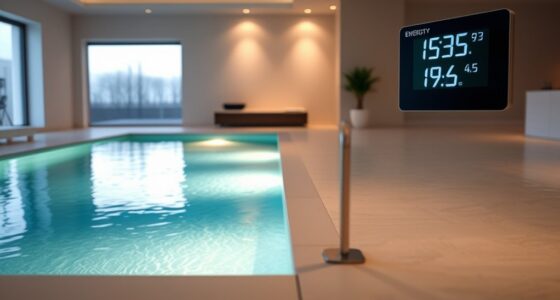Choosing between chlorine, salt, or UV for your Endless Pool depends on your priorities. Chlorine is effective and affordable but can cause skin and eye irritation. Salt systems generate their own chlorine, offering gentler comfort but may require more maintenance. UV sterilization uses light to sanitize water without chemicals, providing a eco-friendly, low-irritation option. Each method has pros and cons; exploring the details will help you find the best fit for your pool and lifestyle.
Key Takeaways
- Chlorine offers proven, effective disinfection but can cause skin and eye irritation if not properly balanced.
- Saltwater systems generate chlorine naturally, providing a gentler swimming experience with less chemical handling.
- UV sterilization uses light to kill pathogens chemically, reducing irritants and chemical byproducts in your pool.
- Consider maintenance, cost, and environmental impact—UV and salt systems typically require less ongoing chemical use.
- Choose based on your comfort preferences, sensitivities, and long-term investment in ease of upkeep and water safety.
Understanding Chlorine and Its Role in Pool Maintenance
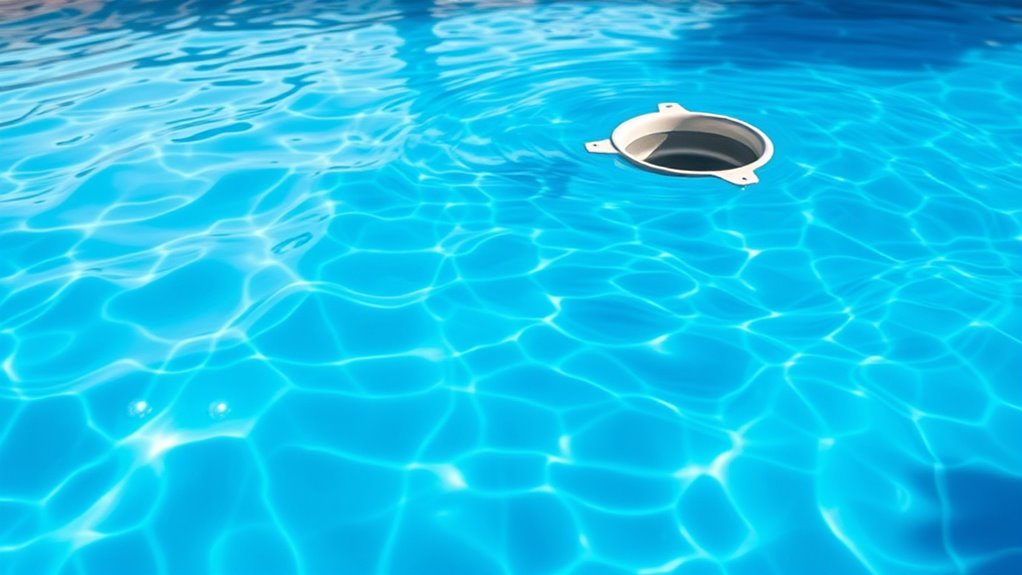
Chlorine is vital for keeping your pool water clean and safe. It works by killing bacteria, algae, and other harmful microorganisms that can make swimming unsafe or cause cloudy water. When you add chlorine to your pool, it quickly dissolves and forms hypochlorous acid, which attacks contaminants. Maintaining the right chlorine level is essential; too little, and your water becomes unsafe, too much, and it can cause skin irritation or a strong chemical smell. You’ll want to test your water regularly using test strips or a kit to guarantee proper chlorine levels, typically between 1-3 ppm. Proper chlorination also helps prevent algae growth and keeps your pool clear, sparkling, and inviting for every swim. Understanding pool chemistry can help you optimize your maintenance routine and ensure a safe swimming environment.
The Benefits and Drawbacks of Saltwater Systems
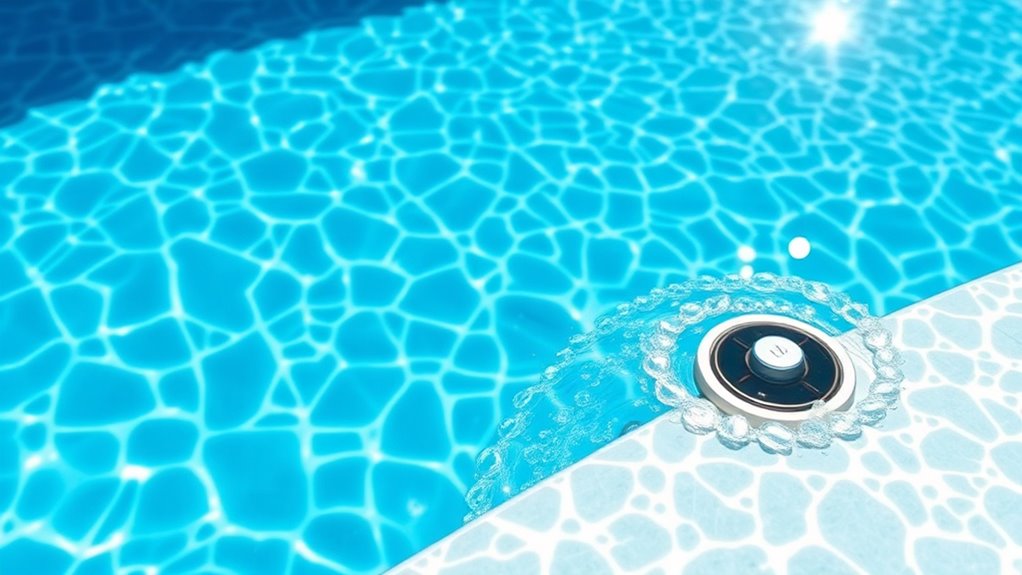
Saltwater systems offer a convenient alternative to traditional chlorine pools by generating sanitized water through electrolysis, which converts salt into chlorine on-site. This process provides a steady supply of chlorine, reducing the need to handle harsh chemicals regularly. Many swimmers find that saltwater feels gentler on the skin and eyes, making the swimming experience more comfortable. However, salt can cause corrosion in pool equipment and surrounding fixtures if not properly maintained. You’ll also need to monitor salt levels regularly to ensure the system functions correctly. While salt systems reduce the frequency of chlorine addition, they still produce chlorinated water, which some people find irritating. Overall, saltwater systems offer ease and comfort, but they require ongoing maintenance and awareness of potential corrosion issues. Active monitoring and proper maintenance help prevent issues like corrosion and equipment damage, ensuring a safe and enjoyable swimming environment.
How UV Sterilization Works to Purify Pool Water
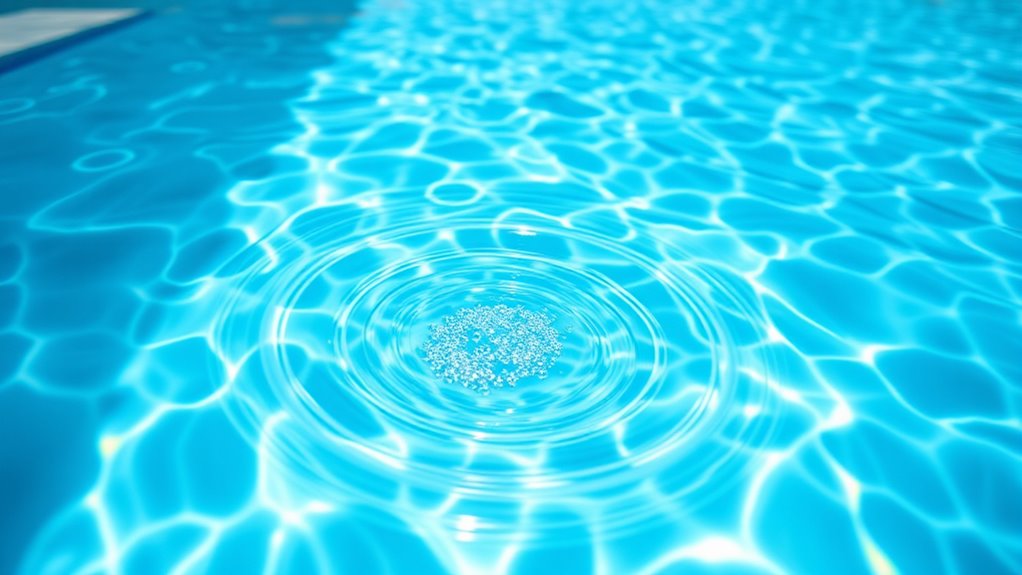
Have you ever wondered how UV sterilization keeps pool water clean without adding chemicals? It uses ultraviolet light to destroy harmful microorganisms. Here’s how it works:
- Water passes through a chamber containing UV lamps.
- The UV light exposes bacteria, viruses, and algae to intense radiation.
- This exposure damages their DNA, rendering them unable to reproduce or cause illness.
- Cleaned water then flows back into your pool, free of most pathogens.
- UV sterilization is also recognized for its eco-friendly approach, reducing chemical use and environmental impact.
UV sterilization is effective, fast, and chemical-free. It doesn’t create chloramines or other byproducts, making your water safer and clearer. This method complements other treatments, like salt or chlorine, to maintain pristine pool conditions effortlessly.
Comparing Costs: Upfront Investment and Ongoing Expenses
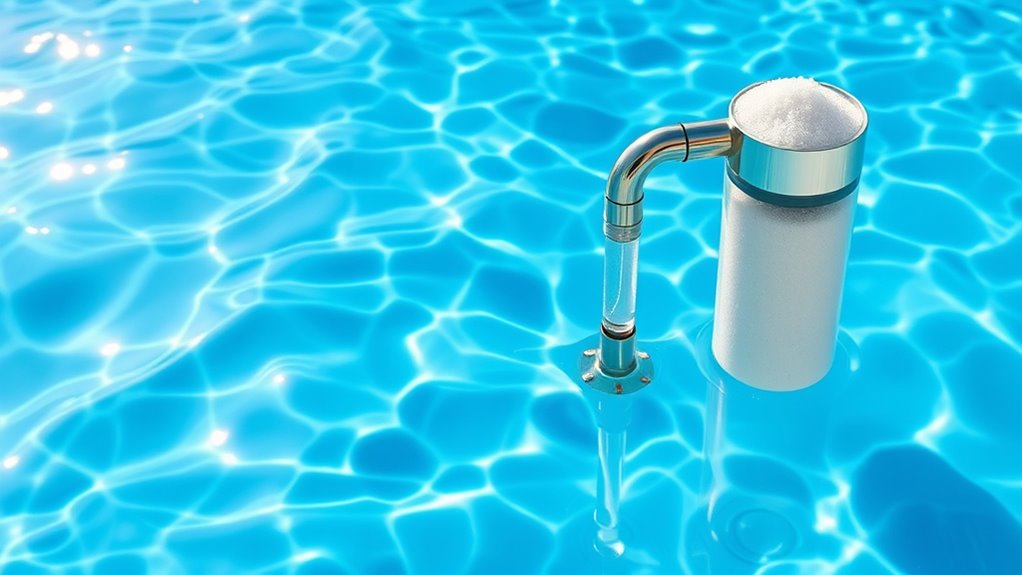
When choosing a pool water care system, you’ll want to compare both initial setup costs and ongoing expenses. Understanding maintenance fees and long-term investments helps you plan your budget effectively. By weighing these factors, you can select a solution that fits your finances now and in the future. Additionally, consider the cost-effectiveness of low-maintenance options like salt or UV systems, which may reduce ongoing costs over time.
Initial Setup Costs
Are you prepared for the initial costs involved in setting up a pool? The upfront investment varies depending on your chosen water care system. Here’s what to expect:
- Equipment purchase, such as salt chlorinators or UV systems, can range from a few hundred to several thousand dollars.
- Installation fees, including plumbing and electrical work, may add considerably to your costs.
- Pool accessories and initial water treatment supplies are necessary to get started.
- Possible upgrades or modifications to your existing setup, like reinforcement or special fittings, could be required.
While these expenses might seem steep at first, they set the foundation for long-term ease of maintenance and water quality. Planning ahead helps ensure a smooth setup process and avoids surprises down the line.
Maintenance Expenses
While the initial setup costs can be significant, maintaining your pool’s water quality over time involves ongoing expenses that can add up. Chlorine pools require regular purchases of chemicals, which can become costly over the years. Saltwater systems have lower chemical costs but need occasional replacement of parts like the salt cell and filters. UV systems have minimal ongoing expenses, mainly energy consumption for operation. You’ll also need to budget for routine maintenance tasks, such as cleaning filters and testing water chemistry. Energy costs vary depending on the system’s efficiency and usage patterns. Overall, your recurring costs depend on the type of system you choose and how often you need to perform maintenance or replace parts. Planning ahead ensures you’re prepared for these ongoing financial commitments. Glycolic acid benefits
Long-term Investment
Choosing the right pool system involves balancing upfront costs with long-term expenses to get the best value over time. When evaluating long-term investments, consider these factors:
- Initial purchase price and installation costs, which vary depending on the system type.
- Ongoing maintenance expenses, including replacement parts and servicing.
- Energy consumption, impacting your monthly utility bills.
- Consumable supplies, like salt, UV bulbs, or chlorine, which need regular replenishment.
- Implementing effective keyword research can help identify the most cost-efficient systems suited to your needs.
While some systems may be cheaper upfront, they could cost more over time due to higher energy use or frequent replacements. Conversely, investing in a more efficient system might have a higher initial cost but save you money in the long run. Make sure to weigh both upfront and ongoing expenses carefully.
Maintenance Requirements for Each Water Care Method

Maintaining your pool water requires consistent attention tailored to each water care method. If you choose chlorine, you’ll need to regularly test and adjust chemical levels, add chlorine tablets or liquid, and monitor pH balance to prevent algae and bacteria growth. Saltwater pools demand less frequent chemical adjustments, but you should check salt levels and confirm the salt cell is functioning correctly, usually every few months. UV systems require minimal ongoing maintenance—primarily cleaning the UV lamp and replacing it annually or as recommended by the manufacturer. Regardless of the method, routine skimming, cleaning filters, and inspecting equipment are essential. Proper calibration ensures your system maintains optimal performance and water quality. Staying proactive ensures your pool remains safe, clear, and enjoyable without unexpected issues.
Impact on Pool Users: Skin, Eyes, and Overall Comfort
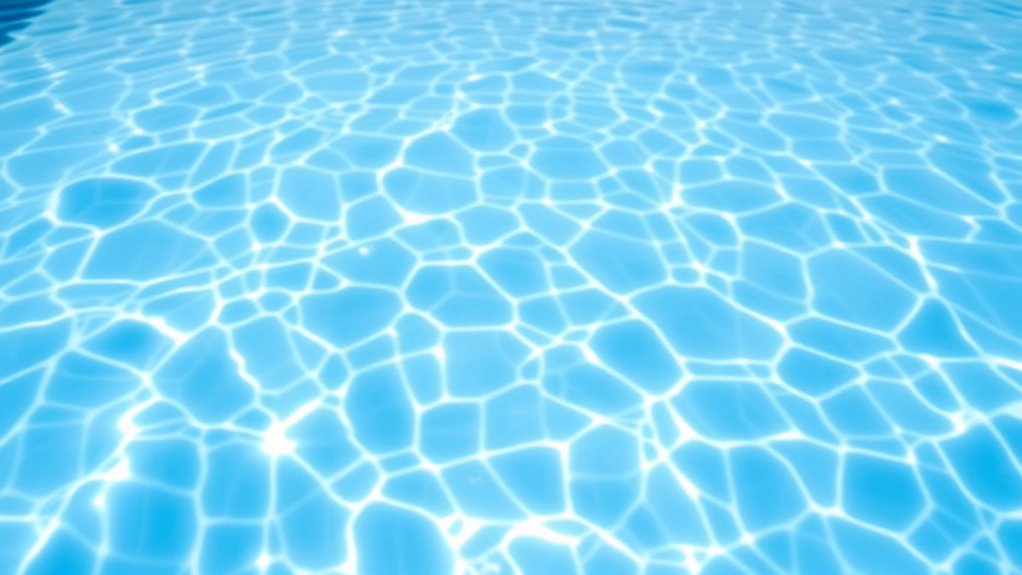
When you swim in a pool, your skin and eyes can become irritated if the water isn’t properly balanced. You might notice discomfort or sensitivity that affects your overall experience. Let’s explore how water quality impacts your comfort and what you can do to minimize these issues.
Skin Irritation Risks
Exposure to improperly balanced pool water can lead to skin irritation, causing redness, itching, and dryness after swimming. When pH levels are too high or low, your skin becomes vulnerable to irritation. Chlorine and other sanitizers can also strip natural oils, worsening dryness and discomfort. To minimize these risks, consider these factors:
- Maintain proper pH levels (7.2–7.8) to prevent skin imbalance.
- Use appropriate sanitizer concentrations to avoid harsh chemicals.
- Rinse off after swimming to remove residual chemicals.
- Keep your skin moisturized with gentle lotions post-swim.
Eye Sensitivity Concerns
Since pool water contains chemicals like chlorine that help keep it safe, it can also cause eye sensitivity and discomfort for swimmers. When chlorine interacts with organic matter, it creates irritants that can sting or redden your eyes. This is especially noticeable for those with sensitive eyes or if the chlorine levels are too high. You might experience burning, tearing, or a gritty feeling after swimming. To minimize discomfort, verify proper chemical balance, use goggles, and rinse your eyes with fresh water after swimming. Some water care systems, like salt or UV sanitizers, produce fewer irritants, making your swim more comfortable. Being aware of water quality and protective measures helps reduce eye sensitivity and keeps your swimming experience enjoyable. Additionally, understanding the offensive tactics used in ethical hacking can help in developing better security measures to protect sensitive information.
Overall Comfort Levels
Maintaining overall comfort in the pool hinges on balancing chemical levels and ensuring proper water quality, as these factors directly affect your skin, eyes, and swimming experience. When chemicals are well-managed, you’ll notice softer skin, clearer eyes, and a more enjoyable swim. To improve comfort, consider these key points:
- Keep pH levels balanced to prevent skin irritation and eye discomfort.
- Use the right sanitizer to maintain clean water without harsh residues.
- Regularly test for alkalinity to stabilize chemical balance.
- Opt for alternative systems like UV or salt to reduce chlorine-related dryness and irritation.
Environmental Considerations and Sustainability
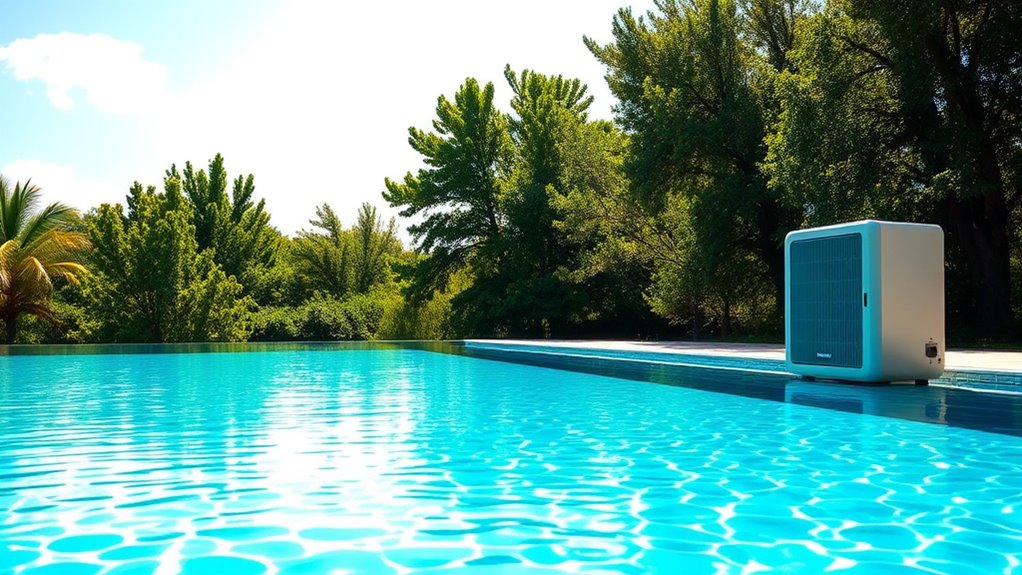
Choosing eco-friendly practices for pool water care not only helps protect the environment but also promotes sustainability. Using less harsh chemicals reduces runoff that can contaminate local waterways and harm wildlife. Saltwater systems and UV sterilization often have a smaller ecological footprint compared to traditional chlorine methods. These options consume less energy and generate fewer chemical byproducts, lowering your pool’s overall environmental impact. Additionally, maintaining proper pH levels and regularly filtering water extends the life of your system and reduces waste. Implementing advanced fraud detection techniques can also help protect your financial transactions related to pool care purchases. Opting for sustainable practices also means conserving resources like water and energy, which benefits your household and the planet. By making mindful choices, you support healthier ecosystems while enjoying a clean, safe pool.
Making the Best Choice for Your Endless Pool
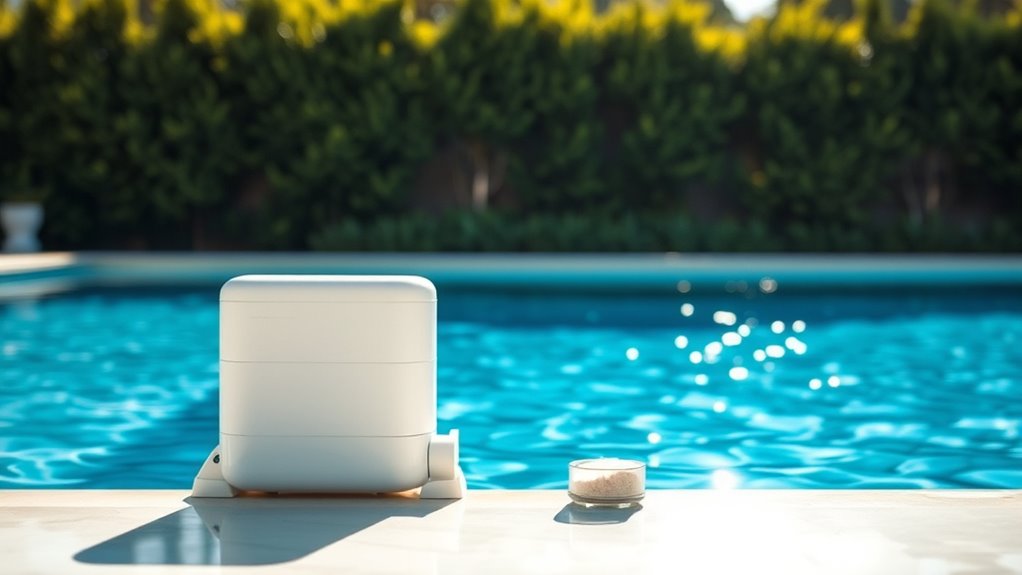
Selecting the right water care approach for your endless pool depends on your specific needs, lifestyle, and environmental priorities. To make the best choice, consider these factors:
- Maintenance Time: Do you want minimal upkeep or enjoy regular cleaning routines?
- Chemical Sensitivities: Are you sensitive to chlorine or salt, influencing your preferred method?
- Environmental Impact: Do you prioritize eco-friendly options like UV sterilization?
- Budget: What are your upfront and ongoing costs for equipment and chemicals?
- Water Quality: Ensuring optimal water clarity and safety is essential for a healthy swimming environment.
Assess how each method aligns with your daily routine and values. Chlorine might be straightforward but requires regular balancing. Salt systems offer convenience, while UV provides chemical-free sterilization. Your ideal choice balances ease, safety, and sustainability for your endless pool.
Frequently Asked Questions
Which Water Care Method Is Safest for Children and Pets?
The safest water care method for children and pets is UV sterilization. It uses ultraviolet light to eliminate bacteria and viruses without adding chemicals, so there’s no risk of skin or eye irritation. You can relax knowing your loved ones are protected from harmful chemicals often found in traditional methods. Plus, UV systems are easy to maintain and provide continuous, effective sanitation, making your pool safer and more enjoyable.
How Do Water Care Options Affect Pool Equipment Longevity?
Your water care choice impacts your pool equipment’s lifespan. Chlorine can cause corrosion over time, especially if levels aren’t maintained properly. Salt systems may lead to mineral buildup or corrosion on components if not monitored. UV systems typically don’t harm equipment but require proper installation and maintenance. Regularly checking and maintaining your system guarantees your equipment lasts longer, regardless of the method you choose.
Can Different Water Treatment Methods Be Combined Effectively?
Yes, you can combine different water treatment methods effectively. For example, using a salt system alongside UV sterilization can reduce chemical use and improve water clarity. Just make certain the systems are compatible and follow manufacturer instructions. Regular testing and maintenance are essential to balance chemicals and equipment performance. Combining treatments can give you cleaner, clearer water while extending your pool equipment’s lifespan.
What Are the Long-Term Health Impacts of Each System?
You might notice clearer skin and fewer eye irritations over time when using UV systems, while salt systems may promote softer skin due to fewer chemicals. Chlorine can cause dryness and respiratory issues if not managed properly. Long-term, UV and salt are generally gentler on your body, but it’s essential to balance system maintenance. Your health benefits depend on proper use and regular monitoring of your chosen system.
Which Method Is Best for Maintaining Crystal-Clear Water Year-Round?
You’ll find that UV systems are excellent for maintaining crystal-clear water year-round, as they effectively eliminate bacteria and algae without adding chemicals. Salt systems offer a softer feel and lower chemical use, but require regular maintenance. Chlorine provides reliable sanitation but can cause irritation and odor. For consistently clear water with minimal fuss, UV is your best choice, ensuring a pristine pool experience every season.
Conclusion
Choosing your pool’s water care method is like picking the right tool for a craft—you want it to suit your needs without adding unnecessary hassle. Whether you opt for chlorine, salt, or UV, each has its own rhythm and benefits. Consider your budget, maintenance time, and comfort. With the right choice, your endless pool becomes a haven—smooth sailing on a calm, crystal-clear sea where every swim feels like a dip in paradise.

